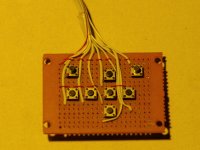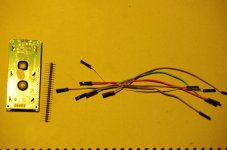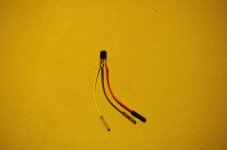Thanks Nick. I'll have to think carefully which way to go.
I am itching to buy though undecided on all the components. The resource thread I posted is still lacking in suggestions. Newbs like me just want a recommended list that makes it easy to order in confidence.
I am itching to buy though undecided on all the components. The resource thread I posted is still lacking in suggestions. Newbs like me just want a recommended list that makes it easy to order in confidence.
So for me CAT5 is not frugal but an akward and extremely sub optimal solution as I can get studd ready-made and just plug in without any hassle.
For me CAT5 was the most elegant and optimal solution. One CAT5 connector and choice of any standard CAT5 cable vs. a special cable with split-offs into 4 RCA's - I know which one I prefer.
Newbs like me just want a recommended list that makes it easy to order in confidence.
I think the may concern is about selecting a proper power supply. A few references have been tested, among which the TDK model that I usually recommend.
For the IR sensor, there are 4 references in the Startup Guide. They are easy to source.
Any LCD is fine as long as it is HD44780-compatible. The only thing you must be careful about is the pinout - it's not standard among LCDs.
Finally, push-buttons and leds: any are fine.
If you're not comfortable with assembling electronic kits, the best is probably that you first place all the components on a wooden board, with stand-offs for Najda and the PSU. Use Dupont wires for pin-to-pin connections: it works well for this kind of applications.
Once that you have gathered all the parts and have tested the assembly on your bench, then you can think about the chassis. It's always a good idea to have the parts at hand at the time you order the chassis, this way you can determine how much space you need and how you're going to place the parts in the box.
You can assemble the project progressively: first wire power supply, LCD and just the StandBy push-button.
(If this is too much, you could start with just the power supply, the StandBy switch and a led in place of the LCD backlight.)
Then you can add the IR sensor and the remaining switches and leds, and make sure navigating through the menu works as expected. Voila! you're done 🙂
Thanks for the encouragement Nick. The power supply will no doubt be one I suggested to you a long time ago, a lab power supply I already have - fixed 5V and variable voltage model.
Admittedly I wanted a cool looking LCD hence was holding out for an OLED, but that is not possible?
Push buttons I have never done, and the cables were a doubt. Could someone link the parts order for all the necessary cables please? I do not want to get the wrong size or shape or however these things come.
Big thanks
Admittedly I wanted a cool looking LCD hence was holding out for an OLED, but that is not possible?
Push buttons I have never done, and the cables were a doubt. Could someone link the parts order for all the necessary cables please? I do not want to get the wrong size or shape or however these things come.
Big thanks
Yay new toy!
Finally got to fire up my Najda for the first time yesterday! In a ghetto plastic storage box with no display and only a single button, but hey, it works! I set it up with active 3-way with the exact same filters/gains I used on my old MiniDSP 8x8, and I already think it sounds better than the minidsp! (probably just expectation bias/placebo, but hey!)
Hopefully my display and chassis will arrive shortly.
With regards to control, I find the need to have 6-7-8 buttons on the front panel to be a menace. I'm looking for a hybrid "joystick" / rotary encoder / button, sort of a 7-in-1 button that can be pressed up/down/left/right/in and twisted left/right. Pioneer employs this thing for navigation in many of their semi-highend stuff (the P88RS/P99RS for example), so I know this kind of thing exists, but I have yet to find it anywhere available to the general diy market. Will post if/when I do. The rotary encoder would require an extra µC and some debouncing caps, but as the total cost of a few caps and an avr is $10 I believe this is doable.
As far as I understood, a firmware update is planned that allows the µC to be controlled via a serial interface (spi/i2c/uart?), is this correct? If/When this happens I will probably replace the buttons/hd44780 with a SoC and a 3.2" tft touchscreen that will be able to display not just DSP stuff but also source/media information. I have big plans for this thing.
Great work Nick, this thing is seriously good stuff!
Finally got to fire up my Najda for the first time yesterday! In a ghetto plastic storage box with no display and only a single button, but hey, it works! I set it up with active 3-way with the exact same filters/gains I used on my old MiniDSP 8x8, and I already think it sounds better than the minidsp! (probably just expectation bias/placebo, but hey!)
Hopefully my display and chassis will arrive shortly.
With regards to control, I find the need to have 6-7-8 buttons on the front panel to be a menace. I'm looking for a hybrid "joystick" / rotary encoder / button, sort of a 7-in-1 button that can be pressed up/down/left/right/in and twisted left/right. Pioneer employs this thing for navigation in many of their semi-highend stuff (the P88RS/P99RS for example), so I know this kind of thing exists, but I have yet to find it anywhere available to the general diy market. Will post if/when I do. The rotary encoder would require an extra µC and some debouncing caps, but as the total cost of a few caps and an avr is $10 I believe this is doable.
As far as I understood, a firmware update is planned that allows the µC to be controlled via a serial interface (spi/i2c/uart?), is this correct? If/When this happens I will probably replace the buttons/hd44780 with a SoC and a 3.2" tft touchscreen that will be able to display not just DSP stuff but also source/media information. I have big plans for this thing.
Great work Nick, this thing is seriously good stuff!
I ordered a OLED display and gave it a try some time ago, but couldn't have it to work. It deemed it DOA. I'll try again some day.Admittedly I wanted a cool looking LCD hence was holding out for an OLED, but that is not possible?
There are also good looking LCDs for a fraction of the price.
Push buttons I have never done, and the cables were a doubt. Could someone link the parts order for all the necessary cables please? I do not want to get the wrong size or shape or however these things come.
As long as you're preparing a setup on a wooden board, I suppose you don't need the best looking wiring, right?
This is my proto keypad: push-buttons assembled on a veroboard.

For the LCD, the easiest is to attach pin headers to the display and wire it with Dupont point-to-point wires:

Below is a IR sensor for test: Dupont wires are at use again.

Hey Bjorn,Yay new toy!
Finally got to fire up my Najda for the first time yesterday! In a ghetto plastic storage box with no display and only a single button, but hey, it works! I set it up with active 3-way with the exact same filters/gains I used on my old MiniDSP 8x8, and I already think it sounds better than the minidsp! (probably just expectation bias/placebo, but hey!)
Hopefully my display and chassis will arrive shortly.
With regards to control, I find the need to have 6-7-8 buttons on the front panel to be a menace. I'm looking for a hybrid "joystick" / rotary encoder / button, sort of a 7-in-1 button that can be pressed up/down/left/right/in and twisted left/right. Pioneer employs this thing for navigation in many of their semi-highend stuff (the P88RS/P99RS for example), so I know this kind of thing exists, but I have yet to find it anywhere available to the general diy market. Will post if/when I do. The rotary encoder would require an extra µC and some debouncing caps, but as the total cost of a few caps and an avr is $10 I believe this is doable.
Good to hear from you, you've been pretty fast at starting your board 😉
I'm currently looking at supporting a rotary encoder. Will be part of the next FW release.
Indeed, I'll look at allowing syncing 2 boards. So Najda would have the ability to send commands, and execute these commands.As far as I understood, a firmware update is planned that allows the µC to be controlled via a serial interface (spi/i2c/uart?), is this correct? If/When this happens I will probably replace the buttons/hd44780 with a SoC and a 3.2" tft touchscreen that will be able to display not just DSP stuff but also source/media information. I have big plans for this thing.
If this works, then I'll publish the details of the commands so that you can control your Najda from you own design.
Great work Nick, this thing is seriously good stuff!
Thanks Bjorn, very glad you like it!
Hi Nick, thanks for the pics and pointers. Most helpful.
I have updated the resource thread, first post, if anyone is interested.
http://www.diyaudio.com/forums/digital-line-level/234773-najda-builds-resource-list.html
Just payed for the amanero board so am committed to buying my own najda now!
I have updated the resource thread, first post, if anyone is interested.
http://www.diyaudio.com/forums/digital-line-level/234773-najda-builds-resource-list.html
Just payed for the amanero board so am committed to buying my own najda now!
Last edited:
Connections Najda to Amp and Amp to Speaker
@SAC:
what do you think about the following concerning the connections:
From the Najda-housing to the right/left amp, assuming you have four main amps in one housing to serve the right/left speaker:
Interconnectors: 5 pin-XLR, for example from the Neutrik NC5-Series (up to 7 pin available)
Cable: f.e. Cordial CMS 4 or Sommer Cable Quantum Highflex Multipair 4
From Amp to Speaker:
Neutrik Speakon 8 poles NL8FC and NL8MPR
Cable: f.e. Cordial CLS 825 (8 x 2.5 mm2)
All of this can be found at Thomann.de for example (prices in Pound on the english versioin), but shurely on many other suppliers´ sites...so I do not provide the links, don´t want to be public relator for anyone...!
B.t.w. I have no experience with the suggested products, but am thinking about the same questions.....
Maybe You can decide, order and have some soldering fun heading Christmas and the new year!
@SAC:
what do you think about the following concerning the connections:
From the Najda-housing to the right/left amp, assuming you have four main amps in one housing to serve the right/left speaker:
Interconnectors: 5 pin-XLR, for example from the Neutrik NC5-Series (up to 7 pin available)
Cable: f.e. Cordial CMS 4 or Sommer Cable Quantum Highflex Multipair 4
From Amp to Speaker:
Neutrik Speakon 8 poles NL8FC and NL8MPR
Cable: f.e. Cordial CLS 825 (8 x 2.5 mm2)
All of this can be found at Thomann.de for example (prices in Pound on the english versioin), but shurely on many other suppliers´ sites...so I do not provide the links, don´t want to be public relator for anyone...!
B.t.w. I have no experience with the suggested products, but am thinking about the same questions.....
Maybe You can decide, order and have some soldering fun heading Christmas and the new year!
What is the "fast roll off/slow roll off" option under board configuration for?
The digital to analogue conversion requires a steep low-pass filter. This task is shared between the DAC itself and the analogue circuitry: The DAC performs most of the filtering in the digital domain, and the analogue buffer finishes the job.
In the digital domain, the DAC implements a FIR filter with linear phase. A FIR filter, as you know, is defined by its coefficients.
The DAC actually embeds 2 different filters (= 2 sets of coefficients): one filter is steeper than the other. The steeper filter has "fast roll-off", the other has "slow roll-off". What this exactly means is illustrated in the CS42428 datasheet Appendix D. With the option you mention in the GUI, you can select which of the 2 filters the DAC should use.
In theory, the "fast roll-off" filter will perform better in the frequency domain, but worse in the time-domain (e.g. ringing). So the trade-off is better rejection or better time response.
In practice, the difference is pretty subtle, don't expect a radical change in what you can hear. Still, the option exists in hardware so the user has control over it.
30m20, my setup allows direct wire from amp circuit board screw terminals to the speaker drivers. I have some speakons but will not use them probably, though they seem excellent.
As for interconnects, I quite like the cat5 idea, perhaps the neutrik sockets. I want to avoid heavy insulated cables to go with my cable philosophy so those you suggested may not be for me. Currently using magnet wire to my 4way PLLXOs!
Other ideas are the 8pin din connectors as used with Linn gear, or even minidsp style screw terminals (on the xlr version).
I imagine ordering the najda without the RCAs soldered would delay delivery time significantly so I'll not be getting any najda work done over Xmas.
As for interconnects, I quite like the cat5 idea, perhaps the neutrik sockets. I want to avoid heavy insulated cables to go with my cable philosophy so those you suggested may not be for me. Currently using magnet wire to my 4way PLLXOs!
Other ideas are the 8pin din connectors as used with Linn gear, or even minidsp style screw terminals (on the xlr version).
I imagine ordering the najda without the RCAs soldered would delay delivery time significantly so I'll not be getting any najda work done over Xmas.
I imagine ordering the najda without the RCAs soldered would delay delivery time significantly so I'll not be getting any najda work done over Xmas.
No, there's no extra delay for a board without audio connectors 😉
Thanks Nick, I've decided to stick with using the supplied RCAs.
Now sent you my order for a normal RCA fitted board.
Now sent you my order for a normal RCA fitted board.
Hi,
There's no such voltage on the relay command output.
It's an opto-coupler, which can be seen as an isolated transistor that acts like a switch.
The device used is the FOD852S, please see the datasheet for more details as well as the dedicated section in the startup guide. Basically, the relay command should be in series with the coil of your relay.
Hope this helps,
Nick
There's no such voltage on the relay command output.
It's an opto-coupler, which can be seen as an isolated transistor that acts like a switch.
The device used is the FOD852S, please see the datasheet for more details as well as the dedicated section in the startup guide. Basically, the relay command should be in series with the coil of your relay.
Hope this helps,
Nick
Hi Nick,
I've been very busy recently so almost no time for audio but I see that a beta version of the software is out (1.03).
Does it implement the mixed FIR & IIR that was supposed to be part of the next software release ?
Jean Claude
I've been very busy recently so almost no time for audio but I see that a beta version of the software is out (1.03).
Does it implement the mixed FIR & IIR that was supposed to be part of the next software release ?
Jean Claude
I ordered a OLED display and gave it a try some time ago, but couldn't have it to work. It deemed it DOA. I'll try again some day.
There are also good looking LCDs for a fraction of the price.
Hi Nick, I found this note about an £19 OLED display readily available in the UK;
"All displays are standard HD44780-compatible (well, 99% compatible) 5*7 dot matrix types.
The 99% problem means you need control board software from 2012 or later..."
I wonder if the Najda meets this requirement? I may give it a go unless it definitely will not work. Some discussion here;
Run Away Brainz: Midas 1602 OLED Character Display
Hi Nick, I see the coupling caps are rated at 25V! What DC do they actually see? The caps I'd like to use are only available up to 20V.
A friend changed the caps on his and when we compared, we felt it was a small but worthwhile improvement.
A friend changed the caps on his and when we compared, we felt it was a small but worthwhile improvement.
- Home
- Source & Line
- Digital Line Level
- DSP Xover project (part 2)